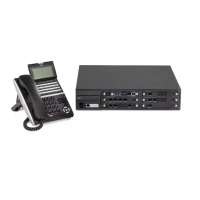Figure 6-3 Network Bottleneck Example
For this example, each end of the network has only one host. Typically, many hosts are sending data
over the narrow bandwidth. The routers buffer packets and transmit them over the WAN lines as
efficiently as possible. When this occurs, certain packets are dropped by the router and some packets
are delayed.
For most data applications this packet loss/delay is not critical. For example, a delay of one to five
seconds to transmit an email is imperceptible. When VoIP is implemented, this loss/delay has a
massive impact on the voice quality. The resulting gaps in speech, distortion and delay are
unacceptable for voice traffic.
To avoid this problem, it is possible to prioritize the VoIP packets. The router examines all packets
received, determines the priority level of the packet, and forwards it accordingly. The data
**1
is
assigned lower priority and the voice is transmitted before the data. This can have a negative impact
on the data network if a lot of voice is transmitted.
Figure 6-4 Voice and Data Network Implementation on page 6-11 shows how a voice and data
network can be implemented.
**1. This description discusses voice and data. These terms are commonly used when describing QoS, although
in the case of VoIP, the voice is actually converted to IP and transmitted as data. Therefore, everything
transmitted on a Data Network is data, but logically we think of this as voice and data traffic.
SL2100 ISSUE 1.0
6-10
Network Design Considerations

